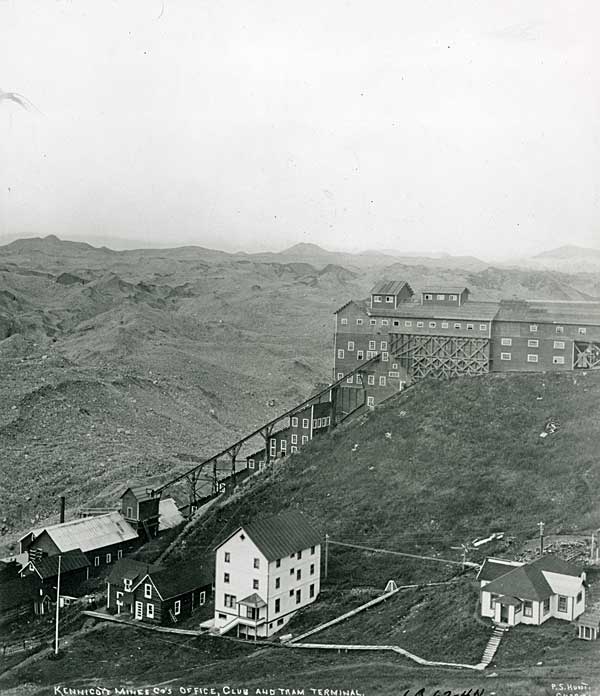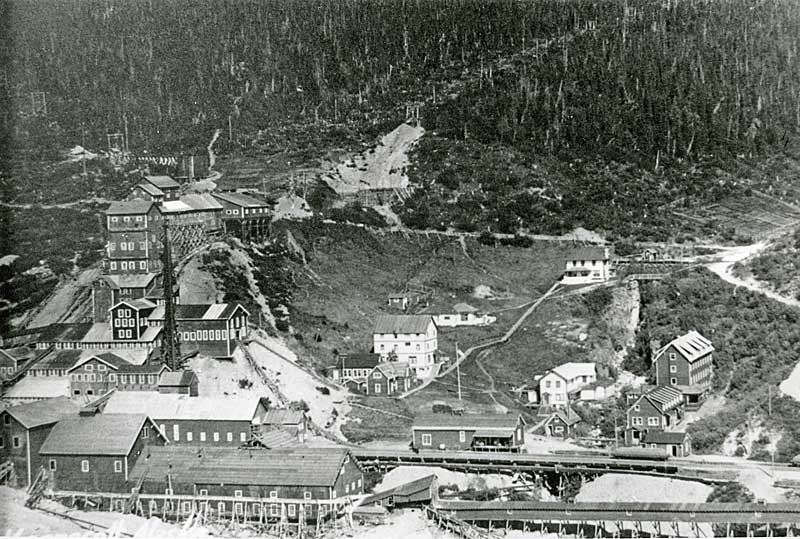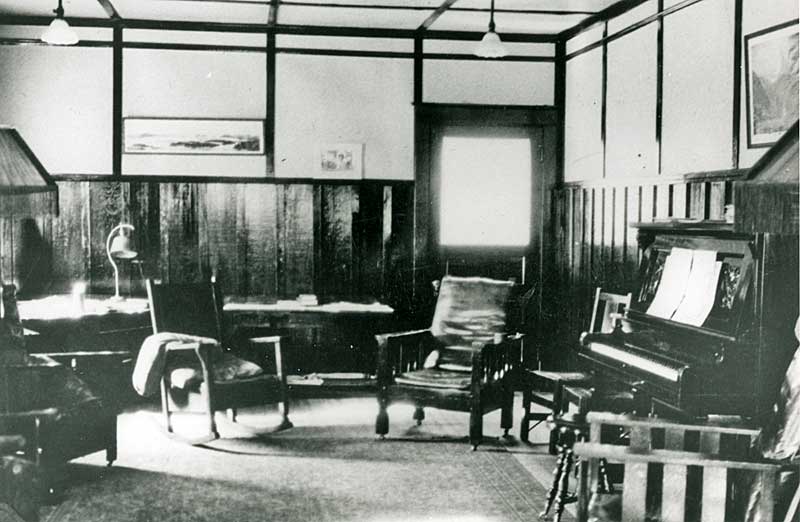For weeks Douglass had been working on a highly detailed report which
was a compilation of the individual reports from each member of the
engineering staff. William Douglass assigned W.A. Richelsen to work with
all of us in settling on the final document which detailed the
operations of the mill and the mine sites. He was particularly
interested in determining the nature of the ore reserves for projecting
the life of the mine.
Everyone in camp was now aware that Birch’s private train had spent
three hours on the siding at McCarthy. The rumors were already buzzing.
Birch was never known to spend time in McCarthy. Something out of the
ordinary was underway. Since the mine had all the appearances of another
banner year of production, and everything was running quite well, few
could imagine the true reason for the visit. High-ranking visitors had
become exceedingly rare. Some ominous meaning had to be attached to it.
Frank walked up the wide L-shaped stairwell to his room on the second
floor. It faced uphill, looking up the sidewalk toward the
superintendent’s residence and the Birch guest house. He could see the
lights coming from two upstairs windows of the guest house, where Birch
and Jackling would stay over the next several days. Tomorrow would come
only too soon. He took off his clothes and set them on the high-backed
chair where the laundry-man would pick them up for cleaning and
starching tomorrow. Pulling on his robe, Frank stepped out into the
hallway holding his toilet articles bag.

Kennecott in
1912 showing rear of staff house. Note the detritus on
Kennicott Glacier in the background. --UAF,
Kennicott Photograph Collection, 60-62-4
|
|
At the north end was a single window which looked
at the hill upon which the main part of the mill and tram terminal
rested well above the staff house. The hallway lights were turned off.
There was just enough light coming through the north-end window to allow
him to find the two bathrooms on this floor. There were also five other
single rooms. All the doors were closed. He could see a light coming
through under the door of one of the bathrooms. He chose the other one.
The door into the large dark bath room was open.
He entered and found the push-switch. After
turning on the light, Frank looked at his mustache in the mirror. It
would have to be trimmed. The facial hair helped the young man look more
mature, but it was not thick, like that of Russell or the other older
engineers. He examined his light, slightly wavy hair and realized he
would have to get a haircut tomorrow before the big night. His military
training served him well. Frank wanted to look exactly right. When the
engineers were together, they were usually informal, but two of the
company big-wigs were here. He wanted to look right, but not stand out.
He viewed himself again.
I still look like a kid. How can anyone take me seriously? My report
tomorrow better be right. How else can I ever impress them? I can’t even
take myself too seriously. Look at me. I can’t even grow a decent
mustache. Oh well. I’m here at Kennecott. I wanted it. I have it. That’s
a good start, anyway. Can’t let myself get too comfortable about being
here. The place is too much like home. Can’t get complacent. Have to
stay sharp. This is my career on the line. Heck, I’m too tired. I’ll
deal with this tomorrow.

National Creek Complex,
early 1920s. The National Creek dam is in view to
the right of the Birch house, which is at the top of the board walk. --McCarthy-Kennicott Museum
|
|
Morning came early. It was six-thirty when Frank emerged from his room
to head for the staff annex for breakfast. He headed down the inside
stairs, out the door and down another set of stairs. The wide wooden
sidewalk ended at the private mess in the annex. The direction he
followed was downhill, passing office, then the hospital. At the base of
the hill a wide bridge crossed National Creek just upstream from the
flume which passed below the railroad trestle, channeling the creek
toward the glacier a few hundred feet below. A few years before, E.T.
Stannard had the carpenters revamp the first floor of the original
National Creek barracks, so the engineers could have their own mess
hall. That was the year the company opened the huge west barracks that
contained a 150-man dining hall. The working men now ate at the west
barracks. National Creek barracks no longer housed nor fed the workers.
The engineers would first gather for the day at the early breakfast in
the private mess. This was the first opportunity to compare notes before
officially beginning the day. These were the unmarried ones who lived in
the staff house. This year there were eight of them. There were two
other high-ranking ones who had wives on the site. The superintendent
always ate breakfast at his home uphill from the staff house, while the
chief engineer ate in his residence along the north cottage row across
from the power plant. This gave the lower ranking engineers an
opportunity to compare notes before facing the bosses in the office at
eight. The group of eight was talking among themselves much more than
usual at breakfast . They had only a few hours to finish the reports.
Some wanted to arrive at optimistic conclusions about the remaining ore
reserves, while a minority preferred the more realistic deduction that
there were no more major ore bodies.
The minority, including Frank were only mildly
impressed with the discovery of the four new veins along the Jumbo-Erie
crosscut. Frank happened to be the one who was working on the report
concerning the Jumbo-to-Erie 12,000-foot-long crosscut. The new tunnel
had been rushed to completion so that it could be operational by the
time Birch arrived. The deadline had been met with little time to spare.
By the time the distinguished guests arrived, the thirty-inch gauge
track would already be in place so the visitors could ride down the new
tunnel in a large ore car pulled by a brand-new battery-powered
locomotive purchased just for running that tunnel.
Above: early shot of the Kennecott engineers, circa 1912
--E.B. Schrock #84-80-98N, UAF AK & Polar Regions Photo Archives |
Below: Late 1930s shot of the Kennecott engineers
--W.A. Richelsen |
The engineers were in the process of examining four newly-discovered
copper veins encountered during the driving the tunnel. It was the first
new copper discovery in any of the mines this year. They had not yet
determined the value of the showings, but had to make an educated guess
for the report.
Frank found the veins to be interesting, but not spectacular. He saw
nothing which showed him that they would amount to much. The assay
reports were good, but they gave no indication as to the size of the
veins. That could only be confirmed with core samples taken by diamond
drilling. The process was underway, but there were not enough samples to
arrive at a satisfactory conclusion. Frank noticed that the all the
samples showed relatively shallow veins before the drill-heads would
strike the barren host rock. This indicated to Frank that each of these
veins was likely to be relatively small. The head engineer, W.A.
Richelsen agreed with Frank’s conclusion. But Douglass seemed to want to
believe that the copper veins were major finds.
Frank wanted to be able to tell his bosses that they had found major ore
bodies, but his conservative nature led him toward the conclusion that
the discoveries were probably only of minor value relative to the great
Jumbo or the Bonanza veins. His experiences in the trenches in the Great
War taught him never to be too optimistic.
Frank pondered the matter long after breakfast as he sat at his desk
wondering how best to evaluate the four new showings in the next few
hours. Just then Russell popped his head into my cubicle of an office.
“It’s official, Frank. We’re all invited to dinner up at the Birch
house. This will probably be followed by some poker and cigar smoking,
and possibly some brandy or whiskey. Mrs. Nieding will oversee the
dinner. After dinner we engineers will be left alone to talk about
whatever we want, up to a point, of course. It’s supposed to be
semi-formal. W.A. recommends we wear our formal suits, just to be on the
safe side. We’ll assemble in the back room of the staff house and head
on up there at seven this evening.”

Staff house parlor room.
--UAF AK & Polar Regions Photo Archives, Alaska Hst Soc, 84-48-37
|
|
“Sounds great to me, Russell. I have my formal suit pressed and ready in
my closet. Anything else?”
“Yes, stick to engineering subjects unless W.A. hints to us otherwise.
We have to be careful around these high officials to give them a feeling
of complete confidence in us. Don’t get into anything personal, and
don’t have any complaints. Everything is fine here. Right?”
“I got that, Russell. No problem. I’m just delighted to be among these
great engineers. I see it as an opportunity. I’ll remember that I have
no problems here. And, actually, I don’t. I love this place.”
Superintendent's residence on the left,
Birch house on the right, East Bunkhouse below Birch House,
hospital below Sup't res. --Nat Good #79-102-31, UAF
AK & Polar Regions Photo Archive |
“See you in the back meeting room of the staff house a few minutes
before seven. Dress right.”
“Thanks, Russell. I’m an ex-officer. I think I can do that without any
problem.” Frank turned back to his report, pondering over the possible
conclusions which would meet the approval of Douglass.
I guess I better show some optimism, or Douglass won’t be happy, even
though I’m not impressed with the four ore veins I examined. No one
seems to think there’s anything major up there.
The eight engineers living in the staff house assembled in the rear
meeting room on the main floor of the staff house full business attire
early so they could discuss their matters of concern before meeting the
higher-ups. W.A. Richelsen, entered at five minutes to seven, looked
over everyone, and nodded his approval.
“Gentlemen, we are about to meet our top bosses at the Stephen Birch
house. We have not had an event like this since 1916. We must make a
good impression with Birch and Jackling, as is quite obvious. Follow my
example and my lead, and everything should go well. Dinner is
semiformal, so act accordingly. Watch Birch and Jackling very closely
and then look at me before you say or do anything. Now let’s head on
out.”
The group headed out of the meeting room, down the short hallway and
through the front room, which was the preferred common area for the
staff of men and women who lived there. The women occupied the third
floor. The front room was on the main floor in the southwest corner. It
had two large windows on each wall overlooking the office and the
glacier. The view from these windows was quite impressive due to the
relative height of the staff house to the large buildings at track
grade. Beyond the front room was the wide entryway and stairwell. The
front door opened to a wide porch and a set of stairs leading one level
down to the walkway. The group turned up the walkway, heading uphill.
The rambling single-story Douglass residence was uphill on the left.
Riding behind National Creek dam at
Kennecott, circa 1911. The manager's (Stephen Birch) house
was built just downstream and to the right of this dam in
1916. --Simpson files |
To the right they could hear the roar of National Creek where a
thirty-foot waterfall plunges into a narrow gorge below the walking
bridge in front of the Birch house. The narrow gorge funneled the creek
to the back of the hospital. This was a wide area which then narrowed as
the creek turned to pass between the two barracks to the south and the
hospital on the north. The creekbed below the waterfalls was a flood
plain. No one had expected the creek to be subject to flooding,
especially since there was a dam above the Birch house which would
normally control the rate of flow. Yet the creek sometimes threatened
the foundations of these three buildings during heavy rainfalls and when
the snow was rapidly melting in the mountains just above the mill site
in May and June.
|
No comments:
Post a Comment